Published: 2012-11-25
Reviews: 33840
Modern Vitebsk.
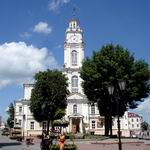 Modern Vitebsk is a large administrative, industrial, scientific and cultural centre. However, the modern city is not trivial Ц its long history has made a unique architectural character of Vitebsk, has shaped a majority of traditions and customs, and Vitebsk residents could be easily distinguished among all Belarusians by inimitable mentality and outlook.
Modern Vitebsk is a large administrative, industrial, scientific and cultural centre. However, the modern city is not trivial Ц its long history has made a unique architectural character of Vitebsk, has shaped a majority of traditions and customs, and Vitebsk residents could be easily distinguished among all Belarusians by inimitable mentality and outlook.
GEOGRAPHICAL LOCATION.
Regarding all the regional centres of Belarus, Vitebsk could be called the most northern city. In any case, its exact geographical coordinates completely confirm this fact. The city is not small Ц with the area being over 12000 hectares. And the area of Vitebsk region exceeds the area of separate countries - Moldova, Armenia, Albania and El Salvador.
 Vitebsk region borders with Lithuania in the west, with Latvia - in the north-west, with the Russian Federation Ц in the north-east. The length of the common border with the neighboring countries totals 933.8 km: with Russia - 575.8 km, Lithuania - 192.2 km, the border with Latvia is 165.8 km. In the south, Vitebsk region joins Grodno, Minsk and Mogilev regions.
Vitebsk region borders with Lithuania in the west, with Latvia - in the north-west, with the Russian Federation Ц in the north-east. The length of the common border with the neighboring countries totals 933.8 km: with Russia - 575.8 km, Lithuania - 192.2 km, the border with Latvia is 165.8 km. In the south, Vitebsk region joins Grodno, Minsk and Mogilev regions.
From east to west Vitebsk region extends over 300 km, and the length from north to south totals 175 km.
The geographical position of Vitebsk could be called successful. There are roads leading to the Baltic States, Ukraine, the countries of the Western Europe. This is evident from the table of distances to the major European cities: Vitebsk-Warsaw - 800 km, Vitebsk-Brest - 638 km, Vitebsk-Petersburg - 602 km, Vitebsk-Kiev - 580 km, Vitebsk-Riga - 514 km, Vitebsk-Moscow - 500 km, Vitebsk-Vilnius - 360 km, Vitebsk-Minsk - 281 km.
CLIMATE.
Vitebsk region is located in the north of the country, so the climate is more severe than in other regions. It is dominated by marine air masses that come from the Atlantic Ocean. Due to these cyclones there is a warming winter, and in summer the sun and clear weather is replaced by clouds and rains. The first snow falls in November, but the real spring begins in late April. The arrival of the warm and sunny summer coincides with the middle of June. In autumn prevail rains and gray weather. Closer to November, there is the first frost.
PEOPLE AND RELIGION.
According to August 2012 data, 367700 people live in Vitebsk - it is the third largest population in Belarus. The city has opened its doors only for Belarusians, but also for Russians, Ukrainians and other communities.
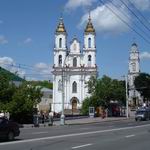
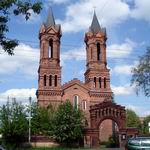 According to the census in 2009, in Vitebsk there are more than 75 nationalities and 80% of all believers refers to the Orthodox faith. The city operates 80 religious communities (45 of them Ц the Orthodox), which belong to the 16 faith - traditional and non-traditional. In modern Vitebsk peacefully exist the Orthodox and the Catholics, the Muslims, and the Old Believers, the Hare Krishnas, Jehovah's Witnesses, the Baptists, etc. The city has two monasteries, five brotherhoods, a sisterhood, and a seminary of Vitebsk Diocese of Belarusian Orthodox Church. In addition, there are three charitable mission of three faiths, two dioceses and two regional religious associations.
According to the census in 2009, in Vitebsk there are more than 75 nationalities and 80% of all believers refers to the Orthodox faith. The city operates 80 religious communities (45 of them Ц the Orthodox), which belong to the 16 faith - traditional and non-traditional. In modern Vitebsk peacefully exist the Orthodox and the Catholics, the Muslims, and the Old Believers, the Hare Krishnas, Jehovah's Witnesses, the Baptists, etc. The city has two monasteries, five brotherhoods, a sisterhood, and a seminary of Vitebsk Diocese of Belarusian Orthodox Church. In addition, there are three charitable mission of three faiths, two dioceses and two regional religious associations.
LANGUAGE.
In Vitebsk, as well as throughout the country, two languages are officially recognized - Belarusian and Russian. Although, most citizens choose Russian as a means of communication. The share of Belarusian speaking citizens in Vitebsk region, however, as in all of Belarus, is inconspicuous - only about 26% of the population speak Belarusian fluently both at work and at home.
MONEY.

 Modern Belarussian money is called "Rubles". Now in circulation are banknotes from 10 to 200,000 rubles: their face value equivalents to 10, 20, 50, 100, 500, 1000, 5000, 10000, 20000, 50000, 100000 and 200000 rubles. Each bill shows the symbolic landmarks of Belarusian culture, located in different parts of the country.
Modern Belarussian money is called "Rubles". Now in circulation are banknotes from 10 to 200,000 rubles: their face value equivalents to 10, 20, 50, 100, 500, 1000, 5000, 10000, 20000, 50000, 100000 and 200000 rubles. Each bill shows the symbolic landmarks of Belarusian culture, located in different parts of the country.
There are no coins, or iron money, in Belarus. But despite this, the country produces commemorative coins in small quantities, which could be undoubtedly the exquisite decoration of a numismatic collection.
ADMINISTRATIVE AND TERRITORIAL DIVISION.
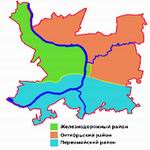 Vitebsk is divided into three administrative districts - Oktyabrsky, Zheleznodorozhny and Pervomaysky. In addition, the boundaries of the city include three suburbs - Guta, Verhovye (Guta-2) and Ruba.
Vitebsk is divided into three administrative districts - Oktyabrsky, Zheleznodorozhny and Pervomaysky. In addition, the boundaries of the city include three suburbs - Guta, Verhovye (Guta-2) and Ruba.
Oktyabrsky district is the central core of Vitebsk, its historical and cultural centre. There are 4 avenues, more than 298 streets and lanes in the district. Their total length is more than 300 kilometers.
Zheleznodorozhny district is truly called a production conglomerate of the city. It also includes the settlements of Guta and Verhovye (Guta-2). The district is large enough - about 50000 people live in an area of 45000 hectares. Ruba settlement is located 15 km far from the city, but despite this, is included in the city boundaries and is subject to the administration of Zheleznodorozhny district.
And Pervomaisky district of Vitebsk is no less attractive. Historically, the citizens emit two blocks in this districts, with the Western Dvina River and the Luchesa River serving as the dividing lines. One of these blocks carries a common name "Markovshchina", the origin of which goes back to the XV century, when male Markov Monastery was built in this area.
CULTURE.
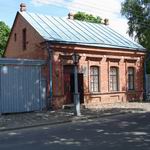 Over the long history Vitebsk has accumulated a large number of cultural and historical sites. Only the national register of historic and cultural values includes 223 sites.
Over the long history Vitebsk has accumulated a large number of cultural and historical sites. Only the national register of historic and cultural values includes 223 sites.
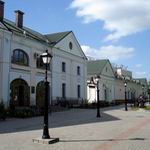 The amateurs of traditional reading appreciate 21 public libraries, the largest of which is Lenin Vitebsk Regional Library. Regional History Museum, Marc Chagall House-Museum and the Center of Folk Crafts "Zadvinye" desert special attention.
The amateurs of traditional reading appreciate 21 public libraries, the largest of which is Lenin Vitebsk Regional Library. Regional History Museum, Marc Chagall House-Museum and the Center of Folk Crafts "Zadvinye" desert special attention.
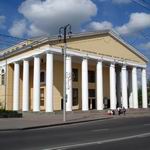 Theater-goers will get great pleasure visiting Yakub Kolas National Academic Drama Theatre and Belarusian Puppet Theatre "Lalka".
Theater-goers will get great pleasure visiting Yakub Kolas National Academic Drama Theatre and Belarusian Puppet Theatre "Lalka".
Vitebsk has the necessary infrastructure for major concerts and festivals. All venues are concentrated under SI "Cultural Centre "Vitebsk", including well-known branches Ц the Summer Amphitheater and Vitebsk Regional Philharmonic Hall.
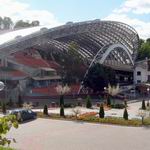 Vitebsk has always been a large city for its time. This is an advantage in times of peace, but a deficit in time of war. In the modern city there are located and maintained in a perfect order a large number of commemorative items - 59 memorial complexes, burial places, major battles and death of civilians, which chronicled the feat of the Soviet people, committed during World War II.
Vitebsk has always been a large city for its time. This is an advantage in times of peace, but a deficit in time of war. In the modern city there are located and maintained in a perfect order a large number of commemorative items - 59 memorial complexes, burial places, major battles and death of civilians, which chronicled the feat of the Soviet people, committed during World War II.
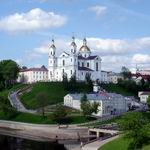 Vitebsk itself is an interesting and unique city that can boast not only a long history with rich traditions, but not less remarkable present times. Among numerous places of worship the most important are the Holy Resurrection Church and the Holy Assumption Cathedral.
Vitebsk itself is an interesting and unique city that can boast not only a long history with rich traditions, but not less remarkable present times. Among numerous places of worship the most important are the Holy Resurrection Church and the Holy Assumption Cathedral.
 Vitebsk goes hand in hand with modern cities and has recently got its pedestrian street. It is ancient Suvorov Street, which has many monuments of the XVIII - beginning of the XX century.
Vitebsk goes hand in hand with modern cities and has recently got its pedestrian street. It is ancient Suvorov Street, which has many monuments of the XVIII - beginning of the XX century.
Vitebsk is a city of festivals. Every year there held more than 20 major cultural events. Undoubtedly, the most famous and important is "Slavic Bazaar" festival, which has long gained considerable international influence and status.
EDUCATION.
In Vitebsk, there are 93 pre-schools, 38 secondary schools, 9 upper secondary schools, 11 colleges, 5 lyceums and 5 higher education institutions.
Among 17 special education institutions agencies particularly distinguished Sollertinsky Vitebsk State Musical College and Vitebsk State College of Culture and Arts stand out separately. In fact, even children and teenagers can join the culture - eight urban arts schools develop their creativity.
The scientific potential of the city is concentrated in five universities. According to this, Vitebsk can be fairly called a student city.
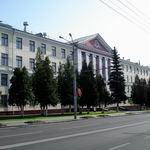
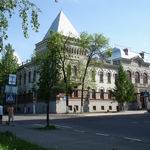 In Vitebsk, there located one of the largest medical universities in Belarus - Vitebsk State Medical University. The only Belarusian university for veterinary medicine is also located in the city on the Vitba Ц it is Vitebsk State Academy of Veterinary Medicine.
In Vitebsk, there located one of the largest medical universities in Belarus - Vitebsk State Medical University. The only Belarusian university for veterinary medicine is also located in the city on the Vitba Ц it is Vitebsk State Academy of Veterinary Medicine.
In addition, there is Vitebsk State Technological University, P. Masherov Vitebsk State University and a branch of the International Institute of Labor and Social Relations in the city.
Educational institutions have well developed sports infrastructure. In addition to traditional gyms and stadiums, there are swimming pools, athletic arenas, gymnastics camps and other facilities. Professional athletic training could be obtained at the Olympic reserve school and high sports school.
MEDICINE.
In Vitebsk, there is a whole range of medical facilities, required for full medical care. The city has 30 major medical organizations, including polyclinics, hospitals, 5 regional dispensaries, a diagnostic centre, preventive facilities. To provide people of pharmaceuticals the city has developed of a wide network of pharmacies.
The feature of the medical infrastructure of the city is centralization of polyclinics. So, in 2009, 5 children's polyclinics in the city and the district were united, resulting in appearance of Vitebsk city central child polyclinic. In addition, there operates city central polyclinic for adults.
Major medical centres in Vitebsk are city central clinical hospital, city clinical hospital є 1, Vitebsk city emergency hospital, as well as two maternity hospitals, an emergency station and an orphanage.
INDUSTRY.
Vitebsk contributes to the "industrial cake" of the region over 20%. It produces one-fifth of industrial production and more than half of consumer goods in Vitebsk region. In the city operate traditional Belarusian branches - engineering, metalworking, light industry, textiles, food processing and the production of construction materials. In general 17400 entities of different types of ownership are located in the city. More than half of the total output is exported. The city enterprises support business ties with 55 countries.
As any large industrial centre, Vitebsk has its branded companies - "Vityaz", "Belvest", "Marko", "Pridvinie" and "Vitba".
TRANSPORT.
Vitebsk region is a part of two major transportation corridors: Berlin-Warsaw-Minsk-Moscow through Orsha and Helsinki-Vitebsk-Gomel-Kiev-Plovdiv, due to this Vitebsk region is well-known far abroad.
Vitebsk air corridor, which passes over the city, serves more than 200 planes a day. By the way, there is its own airport in Vitebsk, which is able to take the majority of modern aircraft.
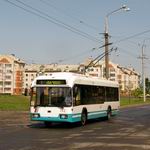
 City public transport is represented by bus, tram and trolleybus routes. People can take taxi and route taxi. Fares are paid in place, in transport, in accordance with the rates.
City public transport is represented by bus, tram and trolleybus routes. People can take taxi and route taxi. Fares are paid in place, in transport, in accordance with the rates.
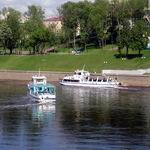 In 2010, the list of land public transport was completed by water transport: in Vitebsk they have restored steamship traffic on the Western Dvina River. You can ride from the Victory Square to the Soviet Army Park (Mazurino). A steamboat goes in both ways.
In 2010, the list of land public transport was completed by water transport: in Vitebsk they have restored steamship traffic on the Western Dvina River. You can ride from the Victory Square to the Soviet Army Park (Mazurino). A steamboat goes in both ways.
INFRASTRUCTURE.
Vitebsk is a modern city with well developed infrastructure. Coming here for the first time, each can find something hidden that will help not forget this city for ever. For maximum comfort the guests could accommodate in the largest hotels "Vetraz" (Chernyakhovsky Ave, 25/1), "Vitebsk" (Zamkovaya Street 5/2a), "Luchesa" (Stroiteley Ave, 1 , the hotel has rooms for the disabled), "Eridan" (Sovetskaya Street, 21/17).
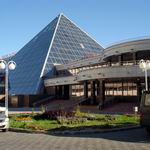 Shoppers should visit the city's shopping and entertainment centres, where even the citizens spend their free time - "Evikom", "Continent", "Belarus", "Marco City" and "Univermag". In Vitebsk shops network is also presented at the proper level - "Vesta", "Vitebskie Produkty", "Nika", "Omega" and "Euroopt".
Shoppers should visit the city's shopping and entertainment centres, where even the citizens spend their free time - "Evikom", "Continent", "Belarus", "Marco City" and "Univermag". In Vitebsk shops network is also presented at the proper level - "Vesta", "Vitebskie Produkty", "Nika", "Omega" and "Euroopt".
Travel market represented more than 30 tour operators looks not less attractive.
Supporters of active recreation and healthy living can admire more than 850 sports facilities - stadiums, arenas, gyms and sports halls, playgrounds for team sports.
The city officials, concerned about the image of Vitebsk as a modern European city, are constantly evolving and improving green spaces, designed for recreation of guests and residents, refining parks and streets, squares and avenues. And at once, as if by magic, Vitebsk turns into an amazing picture, where spacious avenues and cozy, narrow streets, solemnly sober palaces and mirror-laced walls of modern urban development complement each other.
CUISINE.
Vitebsk is a city of contrasts. And this is evident not only in appearance. Lovers of culinary delights could just learn the menu of local restaurants and make sure that the horn of plenty is located in Vitebsk Ц in the city you can easily find Chinese, Japanese, Italian, French and Caucasian cuisine.
However, dishes of Belarusian national cuisine deserve special complimentary reviews, which can also be enjoyed in local cafes and restaurants. And these are not only aromatic potato pancakes and bold pancakes, which recipes have come from time immemorial, from generation to generation. Meat dishes - vereshchaka and mochanka - not less exquisite. Special attention should be paid to hopped krambambulya and herbal sbiten. By the way, beetroot soup, black riser bread, sweet kulaga and curd pancakes are also dishes of Belarusian national cuisine. Although, they have become so commonplace and customared on our table, that it's hard to believe in their "ancient" origin.
MASS MEDIA.
In Vitebsk, state newspaper "Vitbichi" is published. Editor`s offices of regional mass media "Vitebsky Rabochi" and "Narodnoe Slovo" and correspondent office of many national newspapers are also located in the city. In addition to major publications, more than 33 advertising and departmental newspapers are printed in Vitebsk.
Offices of regional television and radio broadcasting company "Vitebsk", TV channel "Art-Video" and non-state TV company "SKIF" are located in the city.
Leisure of Vitebsk residents is provided three cable television operator, as well as numerous radio stations: "Radio Vitebsk" - 91,2 FM, "Radio BA" - 91,7 FM, "Pilot FM" - 92,2 FM, "Europa plus VITEBSK" - 97,8 FM, "Novoe Radio" - 98 7 FM, "Culture" - 99,3 FM, "The First National Channel" - 100,5 FM, "Radio Mir" - 101,8 FM, "Radio Rocks" - 103,0 FM, "Retro FM" - 104 6 FM, "Radius FM" - 105,5 FM, "Radio Minsk" - 106,4 FM, "Alpha Radio" - 107,6 FM.





